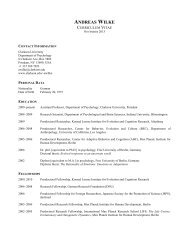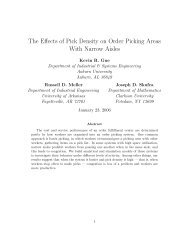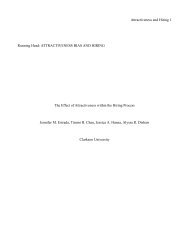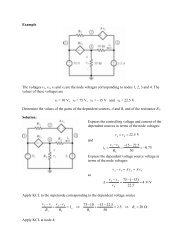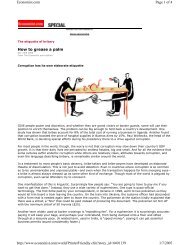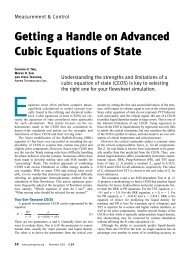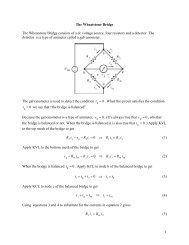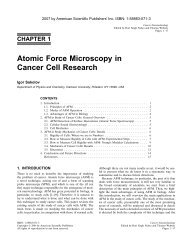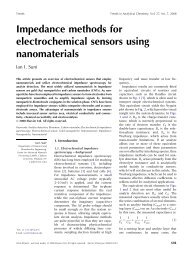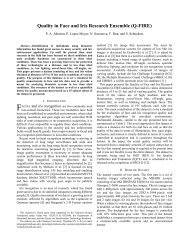Relative Importance of the Effects of Seed and Feed Stage ...
Relative Importance of the Effects of Seed and Feed Stage ...
Relative Importance of the Effects of Seed and Feed Stage ...
Create successful ePaper yourself
Turn your PDF publications into a flip-book with our unique Google optimized e-Paper software.
368 Krishnan et al.<br />
is proportional to <strong>the</strong> square root <strong>of</strong> <strong>the</strong> power input per unit volume (Koh<br />
et al., 1984; Kusters et al., 1997; Lowry et al., 1984, 1986):<br />
<br />
g avg ¼<br />
<br />
2P 0:5<br />
ð14Þ<br />
15mV R<br />
where P is <strong>the</strong> power-input, V R is <strong>the</strong> volume <strong>of</strong> <strong>the</strong> liquid in <strong>the</strong> reactor,<br />
<strong>and</strong> m, <strong>the</strong> viscosity <strong>of</strong> <strong>the</strong> fluid. For a 40, 45, <strong>and</strong> 50% solids batch<br />
emulsion copolymerizations <strong>of</strong> vinyl chloride <strong>and</strong> ethyl acrylate in a 2<br />
gallon reactor, Lowry et al. (1984, 1986) found that <strong>the</strong> amounts <strong>of</strong><br />
coagulum at <strong>the</strong> end <strong>of</strong> <strong>the</strong> polymerization could be correlated to <strong>the</strong><br />
agitation power-inputs using Eqs. 12 <strong>and</strong> 14. Similarly, for semibatch<br />
emulsion polymerization <strong>of</strong> BMA <strong>and</strong> its copolymerization with NMA,<br />
Dave (1998) found that <strong>the</strong> mass <strong>of</strong> coagulum was proportional to P 0.5 ,as<br />
expected from Eqs. 13 <strong>and</strong> 14.<br />
Some experimental results that do not conform to Eqs. 9 or 13 must<br />
also be pointed out. Eq. 13 indicates that amount <strong>of</strong> coagulum is directly<br />
proportional to <strong>the</strong> time to which <strong>the</strong> suspension is subjected to <strong>the</strong> shear<br />
rate g. However, using viscosity measurements, Utracki (1973) has found<br />
that <strong>the</strong> high rate macrocoagulation process was preceded by an induction<br />
period called <strong>the</strong> coagulation time, t c , during which <strong>the</strong> coagulation energy<br />
necessary to overcome <strong>the</strong> threshold energy <strong>of</strong> coagulation, accumulated in<br />
<strong>the</strong> system. Microcoagulation (formation <strong>of</strong> doublets <strong>and</strong> triplets) occurred<br />
during <strong>the</strong> induction period. Instead <strong>of</strong> <strong>the</strong> exponential decrease <strong>of</strong> <strong>the</strong><br />
particle number with time as suggested by Eq. 11, Utracki proposed that <strong>the</strong><br />
number <strong>of</strong> particles decreased linearly with time during <strong>the</strong> induction<br />
period. His <strong>the</strong>oretical equation relating t c to <strong>the</strong> shear rate, g, <strong>and</strong> volume<br />
fraction <strong>of</strong> dispersed phase, f, was confirmed by <strong>the</strong> experimental data for<br />
poly(vinyl chloride) <strong>and</strong> poly(vinyl acetate) latexes. Also, Zollars <strong>and</strong> Ali<br />
(1987) found that when <strong>the</strong> repulsive forces (arising from adsorbed<br />
surfactant, or chemically bound surface groups) between <strong>the</strong> latex particles<br />
were high, <strong>the</strong> shear coagulation rate decreased with an increase in <strong>the</strong><br />
particle volume fraction, f, in contrast to Eq. 10. This unusual result was<br />
attributed to <strong>the</strong> decrease in <strong>the</strong> collisional efficiency with increasing<br />
particle volume fraction. However, when <strong>the</strong> latex particles possessed only<br />
weak repulsive forces, <strong>the</strong> coagulation rate increased linearly with f, as<br />
expected. Their work involved very low particle volume fractions, ranging<br />
from 4.2910 5 to 6.8610 4 . Matejicek et al. (1988) have reported that<br />
during a 52% solids semibatch emulsion terpolymerization <strong>of</strong> styrene, n-<br />
butyl acrylate, <strong>and</strong> acrylic acid, in a 25 dm 3 stirred reactor, <strong>the</strong> amount <strong>of</strong><br />
coagulum decreased with an increase in P/V R below a specific power-input<br />
(P/V R ) <strong>of</strong> 80 W/m 3 . They attributed this coagulum formation to poor



